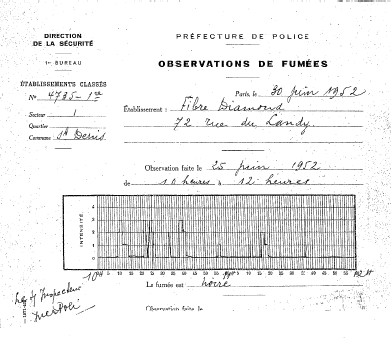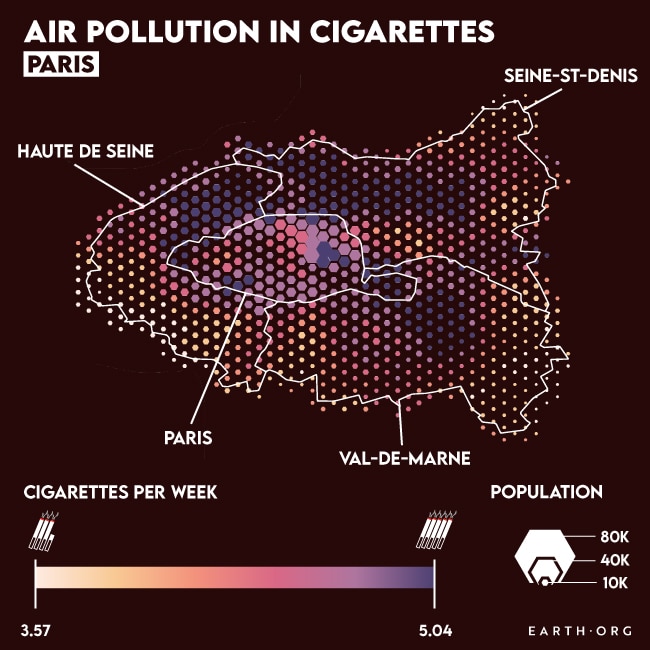Air pollution is the third leading cause of death worldwide, and most large cities, Paris included, have fine particulate matter (PM2.5) levels above WHO health guidelines. Here, we take a look air pollution mapping in Paris and better understand the current situation, and where things may be heading.
—
Lavoisier first started questioning air quality in 18th century Paris, just as the Industrial Revolution was taking place. A first study on (translated): “The question of whether industrial activity which exhales a bad smell is nefarious to health” appeared in 1804, written by two chemists. Despite the subsequent governmental classification of industrial activities into 3 categories by severity, this was based on smell only, as were most of the complaints lodged against the sector for quite some time.
These nuisances were addressed by technical measures, such as minimal height requirements for chimneys and leak-proof walls in factories. However, air quality itself remains ignored.
A host of literature describing the horrible conditions of blackened air and cities appears in the second half of the 19th century, as its noise and pollution became impossible to ignore. It wasn’t until 1898 that a law banning “Heavy and extended black smoke emissions” was passed. However, these issues became an administrative problem rather than a legal one, meaning that surveys were led by hand-picked “experts” and rules were easily circumvented.
Around the year 1900, Parisians knew they had a serious pollution problem. No, not smog and particulate matter, they said, but the dung from over 80,000 horses carrying people and loads around the city everyday. Officials decided to test moving horse-drawn vehicles to the verge of the Champs-Elysees causeway, while motorized vehicles would be given the center. The contrast between the manure-laden and rubber-smoothed aisles left people convinced (translated from a French article in the “Figaro”): “It is easy to see that, from a hygienic standpoint, automobiles whose exhaust is rapidly absorbed by the air, are preferable to equestrian carriages.”
Massive industrialization throughout the century led to many new forms of pollution, and despite some rudimentary measurements of CO2’s distribution through Paris, not much action was taken.
Interestingly, the tool for measuring smoke quality was a set of 5 pieces of paper, shaded gradually from white to black. Smoke color was compared to that of the papers and thus recorded.

Source: https://journals.openedition.org/vertigo/docannexe/image/12826/img-4.jpg
A deadly event in Belgium, 1930, changed the general perception of pollution. The Meuse Valley fog was described as the thickest anyone had seen – it caused many road accidents and killed 60 people by dyspnea (shortness of breath). The three day ordeal was the result of heavy industrial pollution combined with the wrong meteorological conditions.
Similar events in Pennsylvania (1948), Paris (1951) and London (1952) forced authorities to set up regulatory bodies to tackle the problem. Laws setting hard limits on car and industrial exhaust came through in the 60s, and widespread, standardized pollution monitoring appeared in the early 70s.
A growing awareness of the detrimental effects of climate change on the international stage accelerated governmental action from the early 90s onward. Combined with more efficient transport technology, this has culminated in a broad drop in nearly all types of pollution over the city of Paris (i.e. the greenhouse gas CO2, and toxic gases like nitrogen oxides, particulate matter and sulfur dioxide). There is a caveat however: central Paris and a few other high-throughput passages are actually more polluted than they used to be. In fact, 90% of Parisians are exposed to PM2.5 above WHO guidelines (exposure of ~15 micrograms per meter cube compared to a recommended 10).
Ground-level ozone, a chemical mix of other pollutants whose formation is accelerated by sunlight is also on the rise. It irritates eyes, nose and throat, and worsens heart and respiratory conditions. There have been pollution spikes in recent years where people of all ages found themselves coughing and visibly affected by these symptoms.
A mid to long-term plan is in place to reduce traffic and replace diesel cars with an electric fleet, but the parisian mayoral authorities have hit many roadblocks and gone far beyond their budget. Paris air pollution levels are high and unhealthy, yet there is a desire to fix it, it just isn’t that easy.
We illustrate the situation prior to COVID-19 beneath by using an air pollution to cigarette equivalency defined by Berkeley Earth.

Air pollution mapping in Delhi. PM2.5 data from NASA-SEDAC (2016).
There has been a significant drop in pollution since, but Paris air quality is expected to come back to pre-COVID levels once restrictions are lifted. Respiratory disease has now become the third leading cause of death worldwide, behind cardiovascular diseases and cancer, and as developing countries continue to industrialize with loose regulation, the problem will only become worse. It is important to talk about these issues and promote awareness, while actively taking part in your area’s or country’s politics so our concerns can be heard.
This article was written by Owen Mulhern.
You might also like: Bioplastic: A Wolf in Sheep’s Clothing?










![The Statistics of Biodiversity Loss [2020 WWF Report]](https://u4d2z7k9.rocketcdn.me/wp-content/uploads/2020/12/lprwinkyTHB-544x306.jpg)





